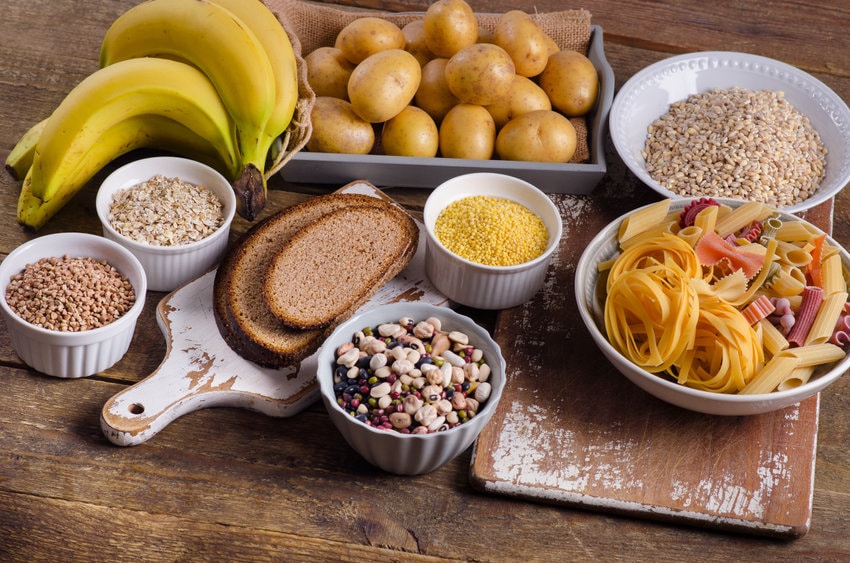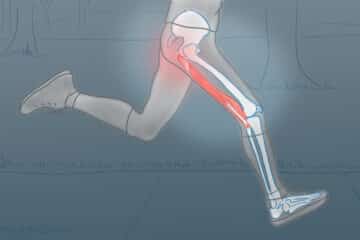
When you’re training for a race or maintaining a certain level of fitness, certain food principles can help maximize your training efforts.
A little science and preparation can help you understand which foods to choose, when to eat them, and how much fuel your body needs. Paying attention to what you eat before, during, and after your runs can affect how you perform and feel.
But the same nutrition plan will not work for every runner. If you asked 10 runners how they fuel their bodies, you’d get 10 different methods. To really discover the ideal training nutrition plan, you’ll need to put these basic principles into place and then experiment.
The Basics of Nutrition for Running
Let’s start with how much you should eat during a run?
The short answer is if you are planning a low-intensity run lasting less than 2 hours, you likely do not need any additional fuel and can get by with just drinking water. If you are running in very dry weather, or very hot and humid weather you may need more fluid and electrolytes than you think.
If you’re planning for a long run over 90-120 minutes, most runners will need to add fuel. Of course, this will depend on your effort, your conditioning, and what zone you’re running in. For zone 2 training efforts you can go longer without feeding, for long lactic threshold progression runs you will need to fuel up.
Well-trained runners with a strong aerobic base can go for runs as long as 90-120+ minutes without eating during the activity. Runners who are pushing past their zone 2 ceiling for a few hours will need to refuel. Any pace above zone 2 is much more costly from an energy perspective.

Calorie needs vary widely based on a person’s weight, height, muscle mass, and physical effort. Yet your body can only store so much energy for glycolysis, which is when we use glucose to fuel more intense efforts. For well-conditioned athletes with solid base training, they are burning more fat to fuel their effort. We have enough fat in us to fuel very long runs at low intensity. For folks without a strong aerobic base or runners planning on pushing above their zone 2 ceiling, you’ll have to consume fuel to maintain your intensity or risk fatigue, more commonly known as bonking or “hitting the wall”.
This post explains how to find your heart rate zones
If you are planning a longer run or a long run at higher efforts, most sports nutritionists recommend 200-300 calories per hour of running. Try eating or drinking 80-100 calories every 30-40 minutes. The right amount will depend again on the length and intensity of your run and your body size. You need to plan on adding these calories throughout the run. Do not wait until you start to feel fatigued.
The type of calories you consume also affects your performance. All three macronutrients (fats, carbohydrates, and protein) play a critical role in keeping you going. Yet, they’re not all needed for the same reason.

The Power and Role of Carbohydrates in Training
Research continues to show the power of carbohydrates for endurance athletes. A 2014 meta-analysis study showed that 82% of the reviewed studies suggested a higher carbohydrate ratio is associated with longer exercise times and enhanced performance. Plus, starting an exercise session with ample muscle glycogen stores can improve exercise performance.
The reason? When you run long distances, the body relies on fat and glycogen as the primary fuels. In tougher efforts, glycogen becomes the rate-limiting fuel source. Glycogen is derived from eating carbohydrates and is stored in the muscles and liver for easy, efficient energy. But our glycogen stores are limited.
The normal range for glycogen stores in muscles is 300-700 grams. The liver stores anywhere between 0-160 grams.
The amount of glycogen particles in an active muscle depends on:
- body composition: more muscle mass means more glycogen storage
- type of exercise: certain activities activate more muscles. For example, indoor biking uses fewer active muscles than trail running.
- fitness level: untrained individuals store less glycogen. This is most likely related to muscle mass, as well as how efficient their muscles are in using and storing glycogen.
- diet: individuals eating a low-carbohydrate diet have less glycogen stored because we cannot store fat and protein as glycogen.
How long do glycogen stores last?
Glycogen storage depletes at different rates depending on the type of activity. Most people’s glycogen stores are depleted after 80 minutes of exercise at a moderate intensity level.
Carbohydrate use is directly correlated with intensity. The harder and faster you go, the more carbohydrates your body uses. Running out of glycogen means it’s the end of your exercise session.

The Roles of Fat
Fat is an essential energy source for your body. Yet, breaking down fat into usable energy is not efficient, and it takes time for this conversion to happen. During low-intensity exercise, your body uses fat as the primary source of energy. Your ability to burn fat for fuel will be highly dependent on how fit you are from an aerobic perspective. Zone 2 training will improve your aerobic fitness, and your ability to utilize fat as a fuel source.
As the intensity increases, your body shifts to carbohydrates for fuel. Yet, well-trained athletes continue to utilize fat long after less well-trained athletes have switched over to mostly using glycogen. Therein lies another huge advantage of having a very strong aerobic base grounded in hours and hours of low HR, zone 2 training.
How to maintain glycogen stores during exercise
When you want to maintain the same performance output for a specific amount of time, it’s important to consider how to maintain glycogen stores.
Your first option is to decrease intensity levels, which slows down carbohydrate combustion and increases fat utilization. As a result, you’re able to maintain glycogen stores for a longer time. This buys you more time at a lower intensity.
The second option is to consume carbohydrates during exercise. Most athletes can start with 200-300 calories per hour of running. Try eating or drinking 80-100 calories every 30-40 minutes. The right amount will depend again on the length and intensity of your run and your body size.

Daily Carbohydrate Needs for Endurance Athletes
The key to maintaining and replenishing muscle glycogen is eating enough carbohydrates daily before and after exercise.
This chart provides recommendations for daily carbohydrate needs. Here are a few key things to keep in mind:
- One gram of carbohydrate is equal to 4 calories.
- Your intake levels can vary depending on the type of training days. If you have easier, lower training days, decrease the amount of carbohydrates on your plate and increase the protein. Take notice of how you feel when you change your plates based on your training levels.
- Your total carbohydrate intake can include the carbohydrates you eat during your activity.
- 1 kilogram of body weight is equal to 2.2 pounds. To covert your body weight from pounds to kilograms, divide by 2.2.
- An example: If a person weighs 160 pounds,
- 160 lbs / 2.2 lbs = 72.7 kgs
- For a moderate exercise day = 72.7 kgs X 5 grams of carbs = 364 grams of carbs per day or 1454 calories per day from carbohydrates
| Amount of Exercise /Exercise Intensity | Grams of Carbs /kg of body weight | Calories of Carbs /kg of body weight |
| Low | 3-5 | 12-20 |
| Moderate | 5-7 | 20-28 |
| High | 6-10 | 24-40 |
| Very-high | 8-12 | 32-48 |
What to Eat During a Run
Don’t worry about consuming energy during a race lasting less than an hour. Your body should have enough glycogen stored up to get you to the end.
For races lasting longer than 60-80 minutes, eat some form of nutrition to keep your intensity where you want it.
Consider adding in some fat with your carbohydrates for marathons and ultra runs that last for several hours. This can help you feel more satiated, especially if your endurance run is low intensity but long. Remember 200-300 calories per hour of mostly carbohydrates.
Follow these initial guidelines for eating on your runs:
- Aim for 30-60 grams of carbohydrates per hour. The key here is to experiment with the amount you can eat without causing an upset stomach. Some runners find it helpful to eat smaller amounts more frequently to reduce stomach issues.
- Most runners can maintain their performance with about 200-300 calories per hour. Most of those calories should come from carbohydrates for moderate intensity activities.
- Don’t wait until the hour mark to fuel. If you plan on being on your run for two hours, you’ll need 400-600 calories total. Start at 30 minutes and eat 100-200 calories and repeat every 30 minutes.
- Try authentic food first. There are lots of portable food options to keep you moving on your run. Gels and energy chews provide a quick boost of energy and can be helpful for shorter distances at high intensity levels. Yet, for longer endurance runs, actual food provides options and additional nutrients that can help maintain performance levels.
Foods that Might Contribute to an Upset Stomach During a Run
The dreaded “runner’s stomach” is when you experience a range of symptoms – from stomach cramps, diarrhea, vomiting, to gas. The body diverts blood flow away from digestion and to the muscles that are being worked. What you eat leading up to and during a run plays a huge role in preventing digestive distress.
Do you have questions regarding an Orthopedic injury or longevity?
Do you want to talk to an expert who can listen to you for 45-60 minutes and explain the options in detail?
Dr. Howard Luks offers remote guidance sessions to review your X-ray or MRI images and explain your options.
Dr. Luks has also received hundreds of requests for educational sessions on the topics discussed in his book, Longevity Simplified.
Certain foods that can trigger an upset stomach more than others include:
- Caffeine
- High-fiber foods – cereal, whole wheat bread, beans, broccoli
- Sorbitol – a sugar alcohol used in beverages. Sorbitol isn’t fully digestible, which means it takes longer to leave the GI tract.
- Dairy – high fat and lactose can affect how your gut feels
- High-fat foods
- High-protein foods
Foods for Endurance Races
Finding the right foods for your endurance run can be a whole blog in itself. The distance and time of your race will dictate some of your food choices.
An important preparation step is reviewing the foods that will be available on race day. If you plan on eating the food that is provided at aid stations, make sure you’ve eaten those foods on training runs. You don’t want to try new foods on race day. Plus, you need a balance of calories, sodium, and fluids so you’ll need little variety during a run lasting longer than two hours.
In longer events, you’re likely moving at a lower intensity. This means you might be able to tolerate more fat and protein than you would if you’re running a marathon at a faster pace.
Consider the following when choosing foods for your endurance races:
- Foods that are low in fiber
- Choosing foods that are low fat
- Review the types of sugar in the food. Some people cannot handle sugar alcohols and varying the types of sugar can be a good way to minimize the risk of discomfort
- Practicality of carrying the food and eating it on the go
Examples of food choices:
- Boiled potato wedges with salt (in sandwich bag)
- Perogies
- Uncrustables
- Fig bars
- Fruit
- Pretzels
- Rice cakes
Nutrition Tips
Pay attention to your overall nutrition.
Having a consistent, well-balanced diet will help your performance during your runs. It’s important to think about the balance between carbohydrates, fats, and protein at most of your meals. Maintaining consistency is better than following a strict diet that removes or highly restricts any of the three macronutrients.
Document your trials and errors.
Figuring out what and how much food works for your individual body while running requires some trial and error. Sometimes you’ll get it right. Other times you might have some stomach issues that tell you something didn’t work.
Drinking your calories counts too.
If you find eating solid foods irritates your gut too much during a run, try getting your nutrition in liquid form. To find the right drink for you, make sure you check out the nutrition label. Carbohydrate rich drinks can help ensure you consume enough calories during a run.
Set timers.
It’s easy to zone out on a run and forget when you last ate, especially on an enjoyable trail. Set a timer on your watch to alarm at 30 minutes to remind you to consume your calories.
Taking it all in
You want your nutrition to help you feel your best and keep you energized. These basic strategies give you a good starting point. Remember, time, intensity, distance, and type of calories are factors to consider when building a solid nutrition plan.












